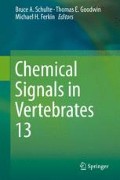Abstract
Several bird species, including zebra finches, have been shown to be able to recognize their own nest, based on olfactory cues. This suggests that differences in nest odor profiles exist. One might assume that these differences are due to differences in food or nesting material. However, laboratory studies led to the assumption that individual body odors of parents and offspring are causing the nest odor differences. In a pilot study, we collected volatile nest odors of zebra finch nests using closed-loop stripping and analyzed them by gas chromatography coupled with mass spectrometry (GC-MS). Our analysis revealed the existence of family-specific nest odor profiles that vary in concentrations of different compounds, providing the basis for odor-based nest recognition.
Access this chapter
Tax calculation will be finalised at checkout
Purchases are for personal use only
References
Albert-Puleo M (1978) Mythobotany, pharmacology, and chemistry of thujone-containing plants and derivatives. Econ Bot 32:65–74
Bang BG, Cobb S (1968) Size of olfactory bulb in 108 species of birds. Auk 85:55–61
Bonadonna F, Cunningham GB, Jouventin P, Hesters F, Nevitt GA (2003) Evidence for nest-odour recognition in two species of diving petrel. J Exp Biol 206:3719–3722
Bradbury JW, Vehrencamp SL (2011) Principles of animal communication. Sinauer Associates, Sunderland, MA
Campagna S, Mardon J, Celerier A, Bonadonna F (2012) Potential semiochemical molecules from birds: a practical and comprehensive compilation of the last 20 years studies. Chem Senses 37:3–25
Caspers BA, Krause ET (2011) Odour-based natal nest recognition in the zebra finch (Taeniopygia guttata), a colony-breeding songbird. Biol Lett 7:184–186
Caspers BA, Krause ET (2013) Intraspecific olfactory communication in zebra finches (Taeniopygia guttata)—potential information apart from visual and acoustic cues. In: East ML, Dehnhard M (eds) Chemical signals in vertebrates 12. Springer Verlag, Berlin, pp 341–351
Caspers BA, Schroeder FC, Franke S, Voigt CC (2011) Scents of adolescence: the maturation of the olfactory phenotype in a free-ranging mammal. PLoS ONE 6, e21162
Caspers BA, Hoffman JI, Kohlmeier P, Krüger O, Krause ET (2013) Olfactory imprinting as a mechanism for nest odour recognition in zebra finches. Anim Behav 86:85–90
Charpentier MJE, Barthes N, Proffit M, Bessière JM, Grison C (2012) Critical thinking in the chemical ecology of mammalian communication: roadmap for future studies. Funct Ecol 26:769–777
Clarke KR, Warwick RM (1994) Similarity-based testing for community pattern: the two-way layout with no replication. Mar Biol 118:167–176
Dorman HJD, Deans SG (2000) Antimicrobial agents from plants: antibacterial activity of plant volatile oils. J Appl Microbiol 88:308–316
Douglas H, Jones T, Conner W (2001) Heteropteran chemical repellents identified in the citrus odor of a seabird (crested auklet: Aethia cristatella): evolutionary convergence in chemical ecology. Naturwissenschaften 88:330–332
Gwinner H (2013) Male European starlings use odorous herbs as nest material to attract females and benefit nestlings. In: East ML, Dehnhard M (eds) Chemical signals in vertebrates 12. Springer Verlag, Berlin, pp 353–362
Gwinner H, Berger S (2008) Starling males select green nest material by olfaction using experience-independent and experience-dependent cues. Anim Behav 75:971–997
Hagelin JC, Jones IL, Rasmussen LEL (2003) A tangerine-scented social odour in a monogamous seabird. Proc R Soc Lond B 270:1323–1329
Hughes BO, Petherick JC, Brown MF, Waddington D (1995) Visual recognition of key nest site stimuli by laying hens in cages. Appl Anim Behav Sci 42:271–281
Krause ET, Caspers BA (2012) Are olfactory cues involved in nest recognition in two social species of estrildid finches? PLoS ONE 7, e36615
Krause ET, Krüger O, Kohlmeier P, Caspers BA (2012) Olfactory kin recognition in a songbird. Biol Lett 8:327–329
Krause ET, Brummel C, Kohlwey S, Baier MC, Müller C, Bonadonna F, Caspers BA (2014) Differences in olfactory species recognition in the females of two Australian songbird species. Behav Ecol Sociobiol 68:1819–1827
Lorbeer E, Mayr M, Hausmann B, Kratzl K (1984) Zur Identifizierung flüchtiger Substanzen aus biologischem Material mit Hilfe der CLSA (Closed loop stripping apparatus). Monatsh Chem 115:1107–1112
Martín-Vivaldi M, Peña A, Peralta-Sánchez JM, Sánchez L, Ananou S, Ruiz-Rodríguez M, Soler JJ (2010) Antimicrobial chemicals in hoopoe preen secretions are produced by symbiotic bacteria. Proc R Soc Lond B 277:123–130
Mennerat A (2008) Blue tits (Cyanistes caeruleus) respond to an experimental change in the aromatic plant odour composition of their nest. Behav Processes 79:189–191
Mennerat A, Perret P, Lambrechts MM (2009) Local individual preferences for nest materials in a passerine bird. PLoS ONE 4, e5104
Minguez E (1997) Olfactory nest recognition by British storm-petrel chicks. Anim Behav 53:701–770
Nevitt GA, Bonadonna F (2005) Sensitivity to dimethyl sulphide suggests a mechanism for olfactory navigation by seabirds. Biol Lett 1:303–305
Petit C, Hossaert‐McKey M, Perret P, Blondel J, Lambrechts MM (2002) Blue tits use selected plants and olfaction to maintain an aromatic environment for nestlings. Ecol Lett 5:585–589
Rezaeinodehi A, Khangholi S (2008) Chemical composition of the essential oil of Artemisia absinthium growing wild in Iran. Pak J Biol Sci 11:946–949
Syu MJ (2001) Biological production of 2,3-butanediol. Appl Microbiol Biotechnol 55:10–18
Acknowledgments
The study was part of the Master’s thesis of SK. ETK was funded by the Volkswagen Foundation (85994). BAC is funded by a Freigeist Fellowship from the Volkswagen Foundation.
Author information
Authors and Affiliations
Corresponding author
Editor information
Editors and Affiliations
Rights and permissions
Copyright information
© 2016 Springer International Publishing Switzerland
About this paper
Cite this paper
Kohlwey, S., Krause, E.T., Baier, M.C., Müller, C., Caspers, B.A. (2016). Chemical Analyses Reveal Family-Specific Nest Odor Profiles in Zebra Finches (Taeniopygia guttata): A Pilot Study. In: Schulte, B., Goodwin, T., Ferkin, M. (eds) Chemical Signals in Vertebrates 13. Springer, Cham. https://doi.org/10.1007/978-3-319-22026-0_12
Download citation
DOI: https://doi.org/10.1007/978-3-319-22026-0_12
Publisher Name: Springer, Cham
Print ISBN: 978-3-319-22025-3
Online ISBN: 978-3-319-22026-0
eBook Packages: Biomedical and Life SciencesBiomedical and Life Sciences (R0)

